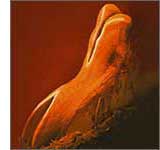A characteristic event of the third week of development is gastrulation - the process of formation of three folia embryonalia (the ectoderm, mesoderm, and endoderm) of the embryo. Gastrulation begins with the formation of a germinal streak on the surface of the epiblast. At first, the streak is weakly expressed, but in a 15-16-day-old embryo it looks like a clear narrow furrow with sections that are somewhat convex on both sides. The head end of the streak, known as the fractionation unit, has the appearance of a somewhat convex area near a small primary fossa. Epiblast cells migrate in the direction of the primary streak. After reaching the germinal streak, they acquire a bottle-shaped form, separate from the epiblast and slip under it. This process is called invagination. After invagination, some cells displace the hypoblast, forming the endoderm of the embryo, while the rest remain between the epiblast and the newly created endoderm, forming mesoderm. The cells that remain in the epiblast form an ectoderm. Therefore, epiblast during gastrulation gives rise to all embryonic layers of the embryo. Before and during gastrulation, the formation of the axes of the body occurs.
The embryonic disc, initially flat and almost round, gradually becomes oblong with a wide head (cephalic) and narrow (caudal) caudal end. Enlargement of the embryonic disc occurs mainly at the head end. The section of the primary strip remains almost the same size. Growth and lengthening of the head of the disk caused by the constant migration of cells from the primary strip and their subsequent migration forward and laterally continue until the end of the fourth week. Further, the primary strip shows signs of regression, quickly shortens and disappears.
Teratogenesis associated with gastrulation. The beginning of the third week of development, when gastrulation occurs, is an extremely sensitive period with respect to teratogenic influences. At this time, the laying of various body systems, such as the visual and nervous systems, takes place, and they can be damaged by teratogens. For example, high doses of alcohol at this stage kill the cells of the anterior end of the midline of the disc, leading to holoprosencephaly. Such a child has a small forebrain, two lateral ventricles often merge into a single ventricle, and the eyes are placed close to each other (hypotelorism). Gastrulation begins two weeks after fertilization, or about four weeks after the last menstruation. Consequently, a woman may not be aware of her pregnancy, assuming that menstruation is late, but will begin soon. Therefore, she will not observe the preventive measures that she would have taken if she knew about her pregnancy.
The process of gastrulation can be disrupted by genetic and teratogenic factors. Caudal dysginesis (sirenomelia) is a syndrome based on the lack of mesoderm formation in the extreme caudal section of the embryo. Since lower extremities are formed from this mesoderm, the genitourinary system (intermediate mesoderm) and the lumbosacral vertebrae, changes in these structures are pronounced. Such children have a number of various defects, including hypoplasia and fusion of the lower extremities, vertebral abnormalities, renal agenesis, genital abnormalities. This malformation may be associated with maternal diabetes.
Sometimes the remains of the germinal streak persist in the sacrococcygeal region. These clusters of pluripotent cells proliferate and form tumors, known as sacrococcygeal teratomas. The latter often contain tissues that originate from all of three folia embryonalia. These tumors are the most common in newborns: they occur with a frequency of 1 in 37,000.
















